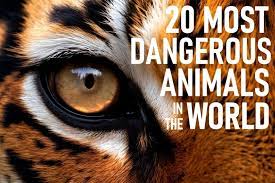The animal kingdom is replete with fascinating creatures, but some stand out for their dangerous capabilities. ‘The Fearsome Ranking: Unveiling the World’s Most Deadly Animals’ takes you on a harrowing journey through the domains of the most lethal animals on the planet. From the depths of the ocean to the skies above, this article reveals the perils lurking in the natural world, where survival often means being the deadliest.
Key Takeaways
- Box jellyfish, sharks, stonefish, and lionfish represent some of the most perilous beings in marine environments, each with unique methods of delivering their deadly attacks.
- Birds of prey like eagles and hawks, along with nocturnal hunters such as owls and cunning corvids, showcase that the skies are equally fraught with avian predators.
- Insects and amphibians may be small, but species like hornets, wasps, assassin bugs, and poison dart frogs pack potent, sometimes lethal, defenses.
- Venomous snakes including vipers, cobras, and the elusive inland taipan possess some of the most toxic venoms, making them formidable and respected threats in their habitats.
- Mammalian predators such as lions, tigers, and leopards epitomize the apex of terrestrial predation, combining raw power with stealth and strategy.
Terrifying Titans of the Sea
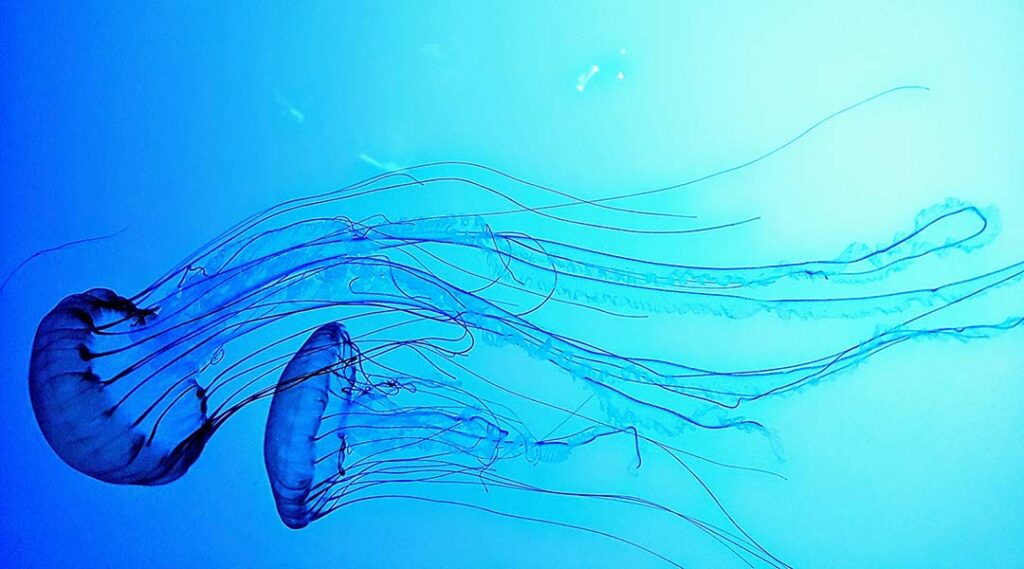
The Lethal Lure of the Box Jellyfish
The box jellyfish, often considered the most venomous marine animal, hides a deadly secret within its seemingly delicate and transparent body. Its venom is so potent that it can cause death within minutes, attacking the heart, nervous system, and skin cells. The allure of its ghostly appearance belies the danger it poses to unsuspecting swimmers in the Indo-Pacific waters.
The box jellyfish’s sting is not only excruciatingly painful but also can be fatal if not treated immediately. Its long tentacles, which can reach up to 3 meters, are lined with thousands of nematocysts that deliver this toxic punch.
While the risk of encountering these gelatinous hunters is relatively low, the consequences can be severe. Here are some quick facts about the box jellyfish:
- Habitat: Primarily found in the coastal waters of the Indo-Pacific.
- Venom: Contains toxins that attack the heart, nervous system, and skin cells.
- Sting: Can cause death within minutes; immediate treatment is critical.
- Appearance: Transparent and bell-shaped, with up to 15 tentacles at each corner.
Understanding the behavior and habitat of the box jellyfish is crucial for beachgoers in affected regions. While their presence is a reminder of the ocean’s hidden dangers, it also underscores the importance of respecting the delicate balance of marine ecosystems.
Stealthy Predators: Sharks on the Prowl
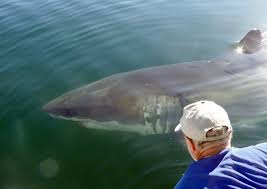
The great white shark (Carcharodon carcharias), often the star of chilling ocean tales, is a formidable apex predator of the seas. Its reputation as a fearsome hunter is well-earned, with a history that traces back to the Miocene Epoch, around 18–12 million years ago.
Despite their notoriety, great white sharks are often misunderstood. While they have been responsible for unprovoked attacks on humans, these incidents may be due to mistaken identity, as humans can resemble their natural prey like seals.
The behavior of these sharks is still shrouded in mystery, but what is clear is their impact on marine ecosystems. Here’s a quick glance at their predatory prowess:
- Single Bite Strategy: Typically inflicts a single, devastating bite on its prey.
- Mistaken Identity: Attacks on humans may occur due to confusion with natural prey.
- Ancient Lineage: Ancestors possibly dating back to the Eocene Epoch (56–34 million years ago).
Understanding these creatures is crucial for both our safety and the preservation of marine life. Their role in the ocean’s hierarchy is as critical as it is terrifying.
Venomous Terrors: The Stonefish and Lionfish

Beneath the waves, the stonefish and lionfish reign as two of the most venomous fish in the ocean. The stonefish, with its wartlike lumps and ability to blend into the rocky seafloor, is a master of camouflage. Its venomous spines can inflict intensely painful and sometimes fatal wounds.
The red lionfish, a species known for its bold, zebra-like stripes, is not only a spectacle in appearance but also in its venomous defense. When threatened, it fans out its spines in a display of intimidation. This species has become an invasive threat to reef ecosystems, particularly in the Western Atlantic, where it has no natural predators.
Both species possess a beauty that belies their danger, and their impact on marine life and human encounters can be profound.
Here is a comparison of their characteristics:
- Stonefish (Synanceia verrucosa)
- Habitat: Tropical Indo-Pacific waters
- Camouflage: Excellent, resembles rocks or coral
- Venom: Extremely potent, can be fatal
- Red Lionfish (Pterois volitans)
- Habitat: Native to South Pacific reefs, invasive in Western Atlantic
- Appearance: Striped with red, brown, and white
- Venom: Painful puncture wounds, rarely fatal
Winged Warriors: The Avian Assassins

Raptors at the Top: Eagles and Hawks
Eagles and hawks reign supreme in the skies, their keen vision and powerful talons making them formidable predators. Their mastery of flight and hunting prowess place them at the apex of the avian world.
- Eagles are known for their impressive wingspans, which can exceed 2 meters in some species.
- Hawks, while generally smaller, are no less efficient hunters, often using surprise and agility to capture their prey.
These birds of prey are not only symbols of strength and freedom but also play a crucial role in maintaining the balance of ecosystems by controlling rodent populations and other small animals.
While attacks on humans are exceedingly rare, the sheer power and speed of these raptors command respect. Their presence in the sky serves as a reminder of the wild’s untamed beauty and the delicate balance between predator and prey.
The Silent Strike: Owls in the Night

Owls have captivated human imagination for centuries, often depicted as wise and mysterious creatures of the night. Their silent flight and sudden strikes make them formidable nocturnal hunters. These avian predators are equipped with an array of adaptations that allow them to locate and capture prey with deadly precision.
Owls’ hunting techniques are a testament to their adaptability and skill. For instance, the Great Horned Owl, with its impressive wingspan and powerful talons, is known to take down prey much larger than itself. On the other hand, the Barred Owl, slightly smaller, still demonstrates remarkable hunting prowess within its territory.
While attacks on humans are exceedingly rare, the defensive behavior of owls protecting their young or territory can lead to startling encounters. These incidents, though infrequent, highlight the owls’ fierce protective instincts.
Owls’ dietary preferences vary, but many species, including the Barred and Great Horned Owls, are known to include rabbits in their diet. This raises concerns for pet owners living in areas where these owls are common. Understanding owl hunting habits is crucial for those looking to safeguard their pets from becoming part of the food chain.
Corvids and Their Cunning: When Intelligence Becomes Deadly
Corvids, encompassing crows, ravens, and their kin, are renowned for their remarkable intelligence and adaptability. Their cognitive abilities rival those of great apes, making them formidable survivors in the wild. These birds are not only capable of using tools but also of planning several steps ahead, a trait once thought to be uniquely human.
While often admired for their smarts, corvids can become aggressive when defending their territory or young. Their boldness and strategic thinking make them a force to be reckoned with, especially for other birds. For instance, nuthatches may find themselves outwitted and outmaneuvered by these clever avians.
Corvids’ territorial disputes and protective behavior can lead to fierce confrontations, sometimes even with humans.
Despite their occasional aggression, corvids play a crucial role in their ecosystems as both predators and scavengers. Their presence is a testament to the complex balance of nature, where intelligence can be just as deadly as fangs or venom.
Creepy Crawlers: Insects with a Deadly Touch
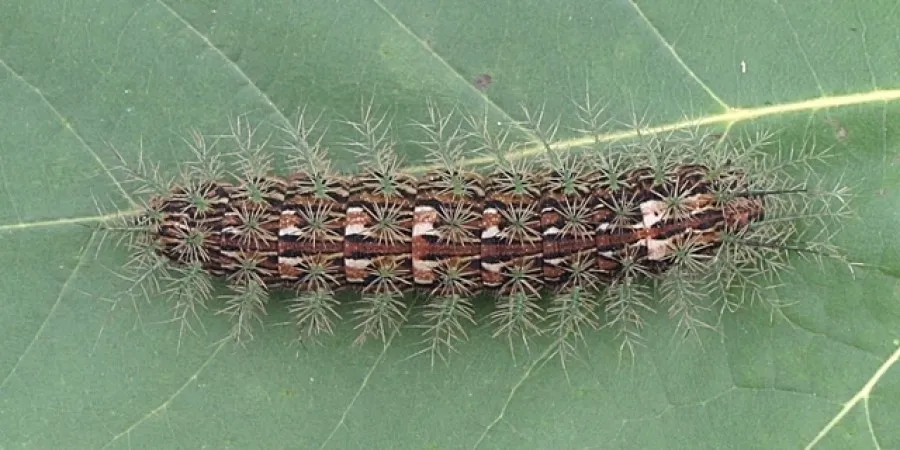
Beware the Sting: Hornets and Wasps
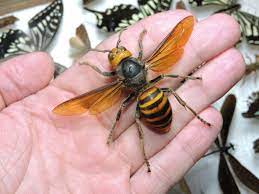
While many insects are dismissed as mere nuisances, the threat posed by hornets and wasps should not be underestimated. Due to their size, hornets are often thought to be more dangerous than their wasp relatives, though aggression levels can vary. The Asian giant hornet, in particular, is notorious for its lethal sting, which has claimed lives in Asia.
In 2013, a series of attacks by these giant hornets resulted in 28 fatalities, highlighting the potential danger these insects can pose to humans. Their venom is highly toxic and can cause anaphylactic shock and renal failure, making them a fearsome adversary.
While encounters with these insects are rare, it is crucial to remain vigilant, especially in regions where they are known to inhabit. Their ability to inflict harm should not be taken lightly, and caution is advised when dealing with or encountering hornets and wasps.
The Deadly Kiss of the Assassin Bug
The assassin bug, a name that conjures images of stealth and danger, is as deadly as it is silent. Their bite not only causes severe pain but can also transmit Chagas disease, a condition that can have long-term health implications. These insects use their proboscis to pierce the skin and feed on the blood of mammals, including humans.
While the initial bite may go unnoticed, the assassin bug’s true threat lies in its ability to spread disease. The symptoms of Chagas disease can vary, but they often evolve over time, starting with acute manifestations and potentially leading to chronic health issues.
The assassin bug’s method of infection is particularly insidious, as it defecates near the wound it creates, allowing the parasites that cause Chagas disease to enter the host’s bloodstream.
Understanding the risks associated with these insects is crucial, especially in areas where they are prevalent. Here is a brief overview of the assassin bug’s impact:
- Transmission: Primarily through bites, but also via blood transfusions, organ transplants, and from mother to child.
- Symptoms: Range from mild to severe, including fever, fatigue, body aches, and in chronic cases, cardiac or digestive complications.
- Prevention: Avoiding contact, using insect repellent, and implementing vector control strategies.
Toxic Beauty: The Poison Dart Frog’s Secret
Despite their diminutive size and enchanting appearance, poison dart frogs harbor a deadly secret. These vibrant amphibians are among the most toxic animals on Earth. Their brilliant colors serve as a warning to predators about the potent toxins contained within their skin.
Astonishingly, poison dart frogs do not produce their own toxins. Instead, they accumulate them from their diet, primarily from consuming certain insects. A protein found in frog bodies may help the amphibians collect and transport toxins from their food to their skin for chemical defense. This remarkable adaptation ensures their survival in the wild, turning their prey’s defenses into their own lethal weapon.
The poison dart frog’s ability to sequester toxins is a fascinating example of nature’s ingenuity in chemical warfare. These toxins can be so potent that indigenous tribes have used them to tip their blowgun darts for hunting, giving these small creatures their notorious name.
While beautiful, it is crucial to respect the danger they pose. Here is a brief overview of their toxicity levels:
- Golden poison frog (Phyllobates terribilis): Considered the most poisonous of the species, with enough toxin to potentially harm 10 adult humans.
- Blue poison dart frog (Dendrobates tinctorius ‘azureus’): Less toxic than its golden counterpart but still dangerous.
- Strawberry poison dart frog (Oophaga pumilio): Exhibits a wide range of color variations and toxicity levels.
Slithering Death: The World’s Most Venomous Snakes

The Fanged Hazard: Vipers and Their Venom
Vipers are synonymous with danger in the reptile world. Their venom, a complex cocktail of toxins, can cause devastating effects on their prey—and sometimes humans. Vipers’ fangs are uniquely efficient, designed to penetrate skin and deliver venom deep into their victims’ tissues.
- Common Viper Species
- Russell’s viper
- Saw-scaled viper
- Pit viper
Each species has its own venom potency and hunting method, but all share the characteristic hinged fangs that allow for a high degree of control when striking.
Vipers are not inherently aggressive towards humans, but they will defend themselves if threatened. Their bites, while rarely fatal with prompt medical attention, can lead to severe pain, swelling, and in some cases, tissue necrosis.
Understanding viper behavior and habitat is crucial for avoiding unwanted encounters. These serpents often lurk in underbrush or camouflaged against the natural environment, ready to strike at unsuspecting prey.
The Cobra’s Hood: A Symbol of Danger
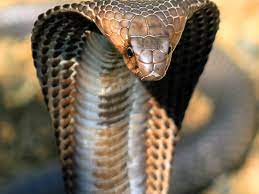
The cobra’s hood is not just a display of intimidation; it’s a warning of the deadly venom that lies within. Cobras are revered and feared across many cultures for their potent venom and aggressive behavior when threatened. Their distinctive hood, which they flare out when facing a threat, makes them one of the most recognizable snakes in the world.
Cobras have a variety of venom components that can cause neurotoxicity, paralysis, and even death. The speed at which they can strike adds to their fearsome reputation.
While not all cobra species possess the same level of venom potency, here are some notable examples:
- Indian Cobra (Naja naja): Known for its significant cultural importance in India, it is also one of the species responsible for the largest number of snakebite incidents in the country.
- King Cobra (Ophiophagus hannah): The longest venomous snake, capable of delivering a large volume of neurotoxic venom.
- Egyptian Cobra (Naja haje): A symbol of royalty in ancient Egypt, its venom is highly toxic and can be fatal.
Understanding the behavior and habitat of cobras is crucial for coexisting with them, especially in regions where they are prevalent. Education and awareness can help reduce the number of negative encounters with these majestic yet dangerous serpents.
The Silent Slither: How the Inland Taipan Strikes
The Inland Taipan, often regarded as the world’s most venomous snake, is a master of stealth and precision. The Taipan can deliver multiple lethal bites in a single attack, ensuring that its prey stands little chance of survival. Unlike some other venomous snakes that inject venom with a single bite, the Taipan can strike repeatedly, each time injecting a potent cocktail of toxins.
With a single bite capable of killing 100 adult humans, the venom of the Inland Taipan is not only deadly but also fast-acting. The snake’s fangs, like hypodermic needles, pierce the skin to deliver this lethal substance directly into the bloodstream.
The Taipan’s hunting strategy is as efficient as it is deadly. It lies in wait, camouflaged against the earth, before launching a rapid series of strikes. Once its venom is delivered, the Taipan retreats and waits for the venom to take effect, tracking the prey if necessary.
Here is a quick overview of the Inland Taipan’s venom potency:
- LD50 value: 0.025 mg/kg
- Average venom yield per bite: 44 mg
- Time to death without treatment: As little as 30 minutes
Mammalian Menaces: When Predators Rule the Land

The King of the Jungle: Lions in the Wild
Revered as the epitome of wild majesty, lions have long been celebrated in folklore and modern media alike. Their social structure is unique among big cats, with pride dynamics that emphasize the importance of the group over the individual.
Lions’ hunting tactics are a testament to their intelligence and physical prowess. They often work in teams to outmaneuver their prey, using a combination of stealth and brute force to secure a meal.
The lion’s roar, a sound that can travel up to 5 miles, is not just a call to arms or a territorial warning; it is a profound symbol of their indomitable presence in the wild.
While they are apex predators, lions face threats from human encroachment and habitat loss. Conservation efforts are crucial to ensure that these regal beasts continue to rule the savannahs. Here’s a snapshot of their current status:
- Population: Approximately 20,000 in the wild
- Habitat: Sub-Saharan Africa and a small population in India
- Threats: Poaching, habitat loss, and conflicts with humans
- Conservation status: Vulnerable, with some subspecies critically endangered
Stealth and Strength: The Predatory Prowess of Tigers
The tiger, an apex predator, is a marvel of evolution, perfectly adapted for the role of a silent stalker. Their agility and strength are unmatched in the animal kingdom, making them one of the most feared predators on land. With a combination of stealth and power, tigers are able to take down prey much larger than themselves.
Tigers employ a variety of hunting techniques that are a testament to their predatory prowess. Tracking the tiger is a crucial part of mastering the art of predation. It requires a deep understanding of their behavior and environment. Here are some key aspects of their hunting strategy:
- Patience and timing: Tigers can wait for hours to find the perfect moment to strike.
- Camouflage: Their striped coat blends seamlessly with the forest, making them nearly invisible.
- Silence: They approach their prey with such stealth that even the slightest sound can betray their presence.
Tigers not only rely on their physical attributes but also on their keen intelligence to outsmart their prey. This combination of brawn and brains is what makes them such formidable hunters.
The Solitary Stalker: Leopards and Their Lethal Tactics
Leopards, the epitome of feline stealth and agility, are masters of ambush. Their hunting techniques are a testament to their adaptability in various environments, from the savannas of Africa to the snow-clad terrains of the Amur region. These solitary hunters rely on a combination of stealth and power, often dragging their prey up into the trees to avoid scavengers.
Leopards possess an exceptional ability to camouflage, blending seamlessly with their surroundings. This skill is crucial for stalking prey and evading larger predators.
Leopards are not only powerful but also intelligent, with a behavioral repertoire that includes nocturnal and crepuscular activity, making them less visible to both prey and humans. Their diet is impressively varied, including small mammals, birds, and even large ungulates, depending on their habitat.
| Prey Size | Frequency of Hunt | Success Rate |
|---|---|---|
| Small | High | Moderate |
| Medium | Moderate | High |
| Large | Low | Low |
The leopard’s adaptability has allowed it to survive in areas where other big cats have dwindled. However, this adaptability also brings them into conflict with humans, leading to a decrease in their natural habitat and numbers.
Conclusion
As we conclude our journey through the fearsome ranks of the world’s most deadly animals, it’s clear that the animal kingdom is replete with creatures both great and small that can pose significant dangers to humans. From the venomous sting of a box jellyfish to the powerful jaws of a saltwater crocodile, nature’s arsenal is diverse and formidable. However, it’s important to remember that these animals are not malevolent; they are simply surviving in their natural habitats. Respect for their space and behaviors is crucial. While the likelihood of encountering many of these deadly animals is low, especially in urban areas, awareness and education remain our best defense. So, whether you’re exploring the depths of the ocean or hiking in the wilderness, stay informed, stay safe, and always marvel at the incredible biodiversity of our planet.
Frequently Asked Questions
Which sea creatures are considered the most deadly?
The Box Jellyfish, Sharks, Stonefish, and Lionfish are among the most dangerous sea creatures due to their potent venom or predatory behavior.
What makes certain birds dangerous to humans?
Some birds, like raptors, owls, and corvids, can be dangerous due to their powerful talons, beaks, and in some cases, their intelligence and territorial behavior.
Are there deadly insects in the UK?
While the UK is not known for deadly insects, it is still possible to encounter harmful species, such as certain hornets or wasps.
What are some examples of venomous snakes and their hazards?
Vipers, Cobras, and the Inland Taipan are examples of venomous snakes that pose serious risks to humans due to their potent venom which can cause paralysis, organ failure, or death.
How do predatory mammals like lions, tigers, and leopards hunt?
These mammals use a combination of stealth, strength, and tactical prowess to stalk and overpower their prey, making them formidable predators.
Where can I find more information on the world’s most dangerous animals?
You can explore detailed articles and lists on reputable websites like Britannica, watch documentaries, and read scientific journals for in-depth information.

